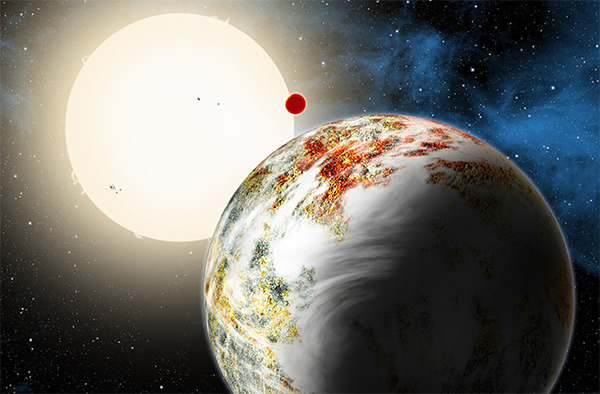Strange New World Discovered: The 'Mega Earth'
Artist's impression of Kepler-10c, an exoplanet that is 2.3 times the size of Earth and 17 times more massive.
Meet “mega-Earth,” a souped-up, all-solid planet that, according to theory, should not exist.
First spotted by NASA’s Kepler space telescope, the planet is about 2.3 times larger than Earth. Computer models showed planets that big would be more like Neptune or the other gas planets of the outer solar system because they would have the gravitational heft and time to collect vast amounts of hydrogen and helium from their primordial cradles.
But follow-up observations of the planet, designated as Kepler-10c, show it has 17 times as much mass as Earth, meaning it must be filled with rock and other materials much heavier than hydrogen and helium.
“Kepler-10c is a big problem for the theory,” astronomer Dimitar Sasselov, director of the Harvard Origins of Life Initiative, told Discovery News. “It’s nice that we have a solid piece of evidence and measurements for it because that gives motivations to the theorists to improve the theory,” he said.
Scientists aren’t sure how mega-Earths, or their diminutive cousins, super-Earths, form, nor why our solar system has nothing in between the largest rocky planet, Earth, and the smallest gas giant, Neptune.
“There was enough material for a super-Earth or mega-Earth to form, so it’s not that the building materials weren’t there. We think that the reason it didn’t form -- or that in some planetary systems they don’t form -- is because the conditions don’t work out to form a bigger rocky planet than the Earth. They don’t get their act together on time and you end up with a bunch of small planets which are rocky and a completely different bunch of bigger planets, which are the gas planets,” Sasselov said.
“We see that the rest of the galaxy’s planetary systems have members in all different shapes and forms,” he added “But how unique is the solar system, we don’t know the answer to this yet.”
The finding of another type of rocky planet has implications in the search for life beyond Earth.
"Solid planets … as far as we know -- and we know very little about origins of life -- is where we think the chemistry is capable of building molecules which lead to the emergence of life," Sassalov told reporters at the American Astronomical Society meeting in Boston on Monday.
Kepler-10c, which has a diameter of about 18,000 miles, is one of two discovered around the sun-like star Kepler-10, located about 560 light years from Earth in the constellation Draco. Its sister planet, Kepler-10b, was the first rocky planet found beyond the solar system. The planets' parent star is much older than the sun, raising another question about how stars dating back to the earliest days of the universe pulled together the materials to form rocky planets, especially big ones.
"We thought that old stars don’t have enough solid material yet to form many rocky planets and hence habitable rocky planets around older stars would be scarce. Probably we were wrong about that. When we are thinking about searching for habitable planets, we shouldn’t discount the very old stars," Sassalov said.(Jun 2, 2014 02:25 PM ET // by Irene Klotz)












